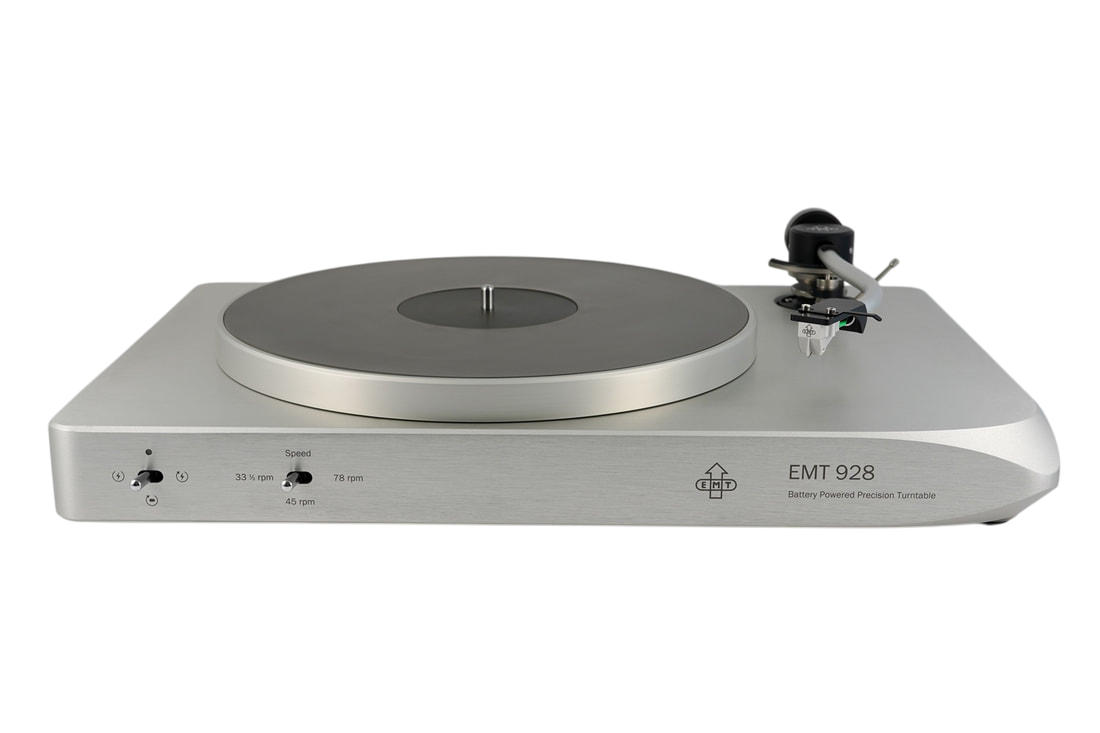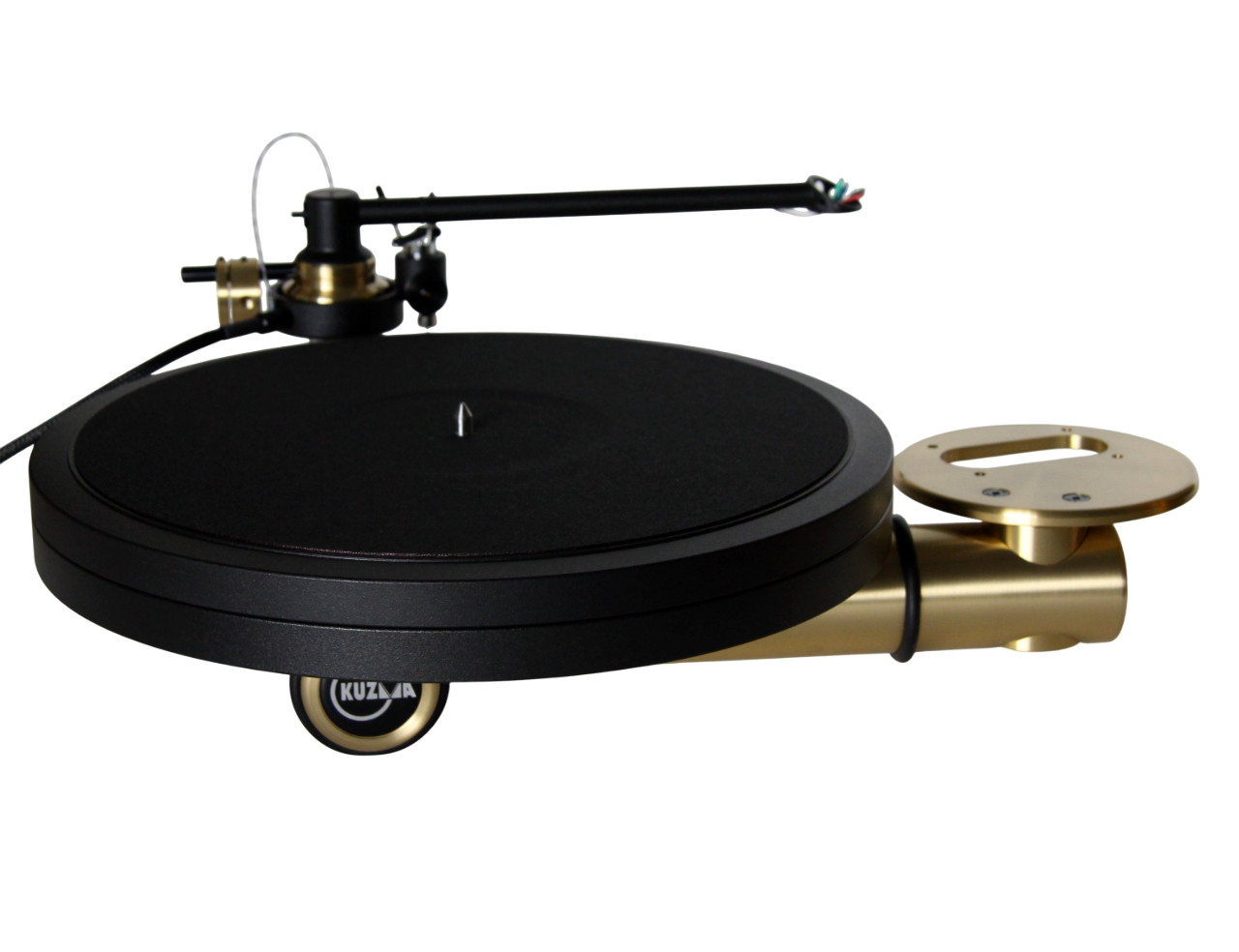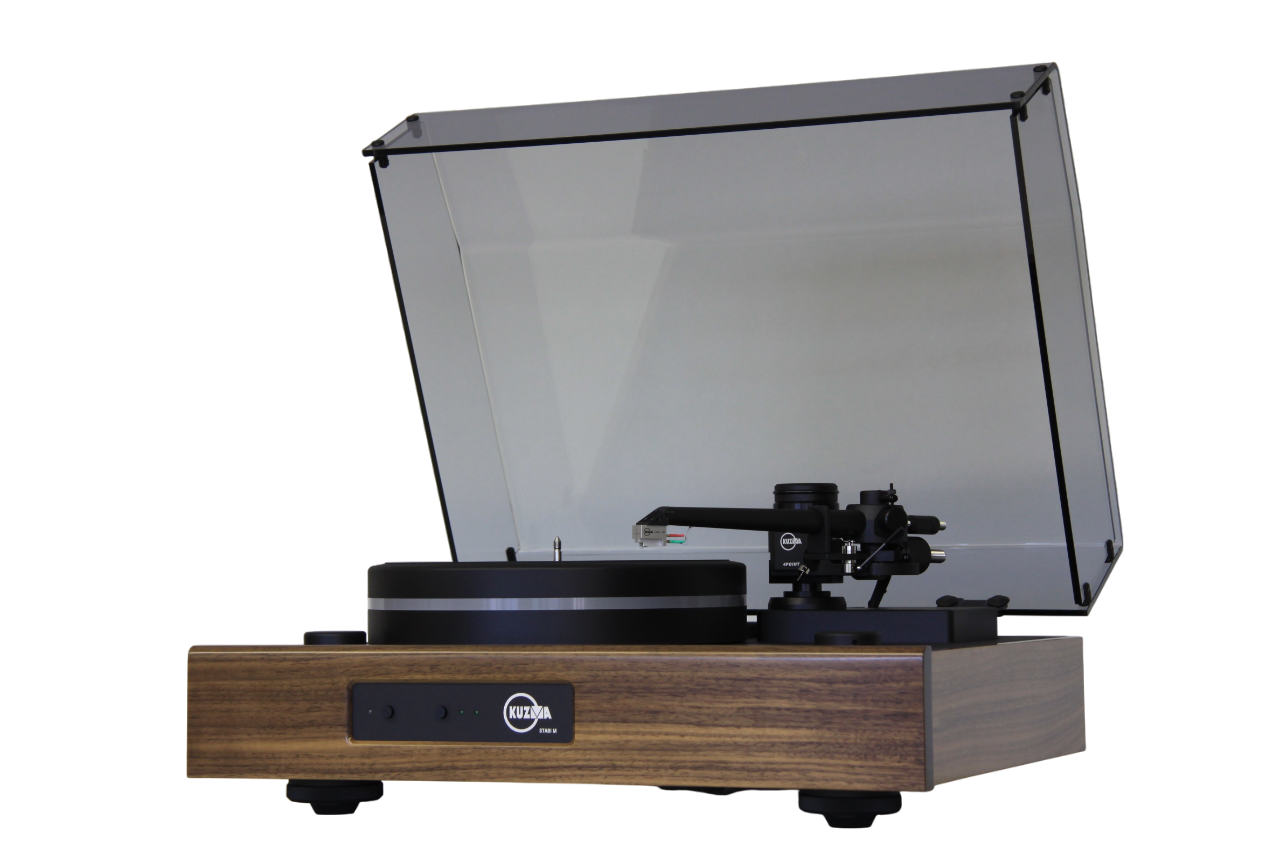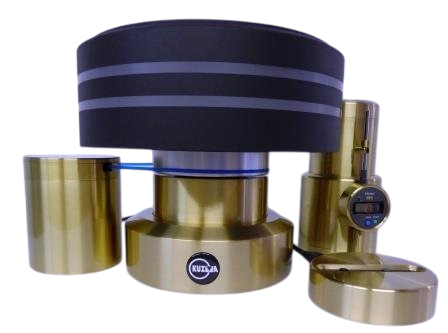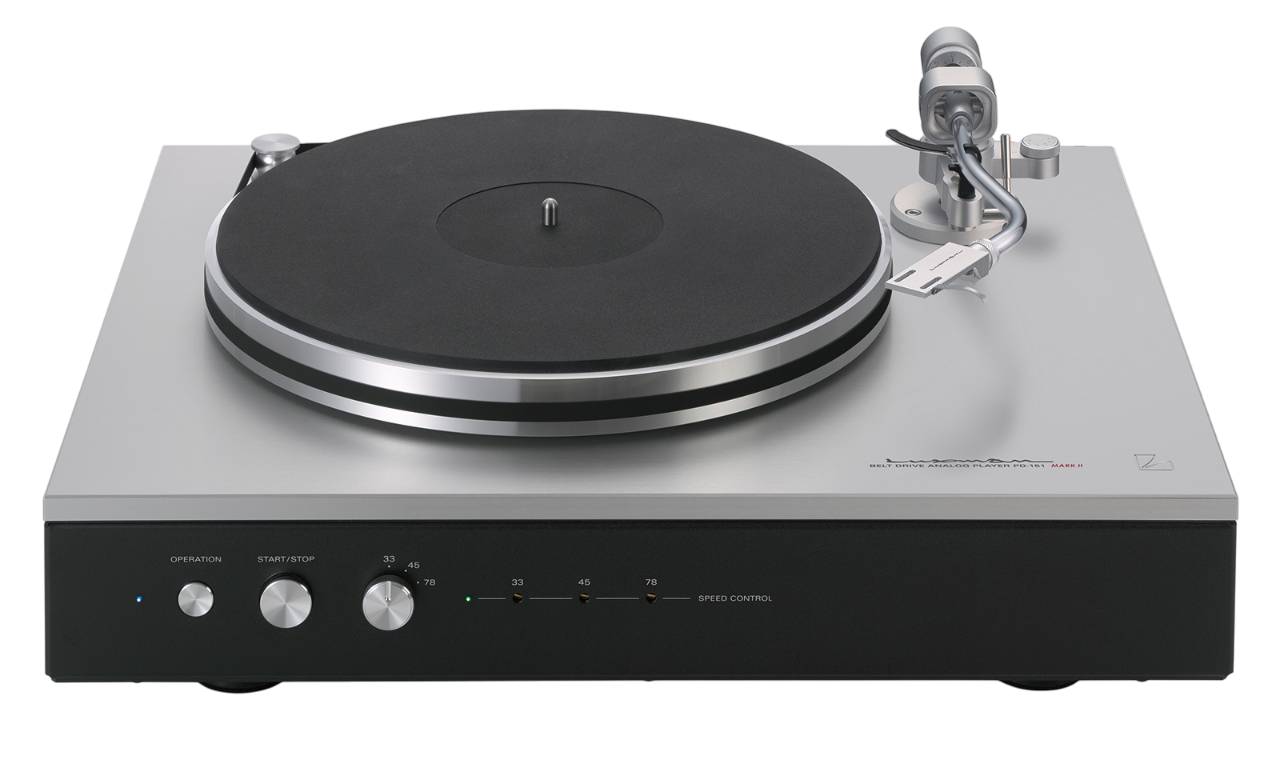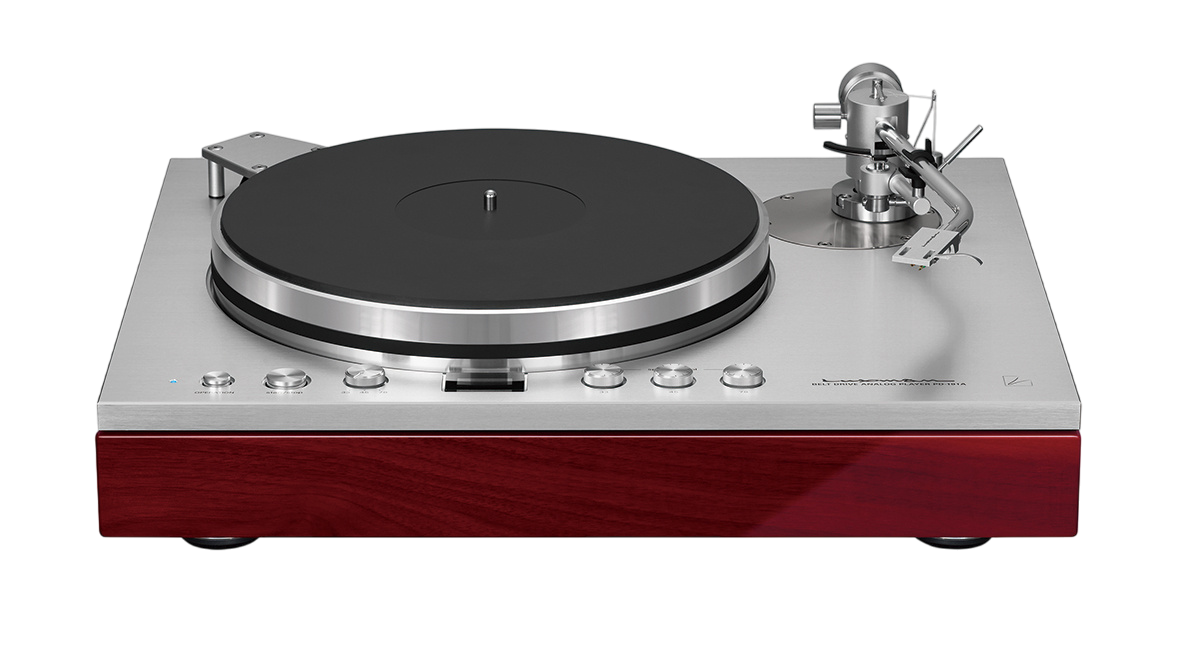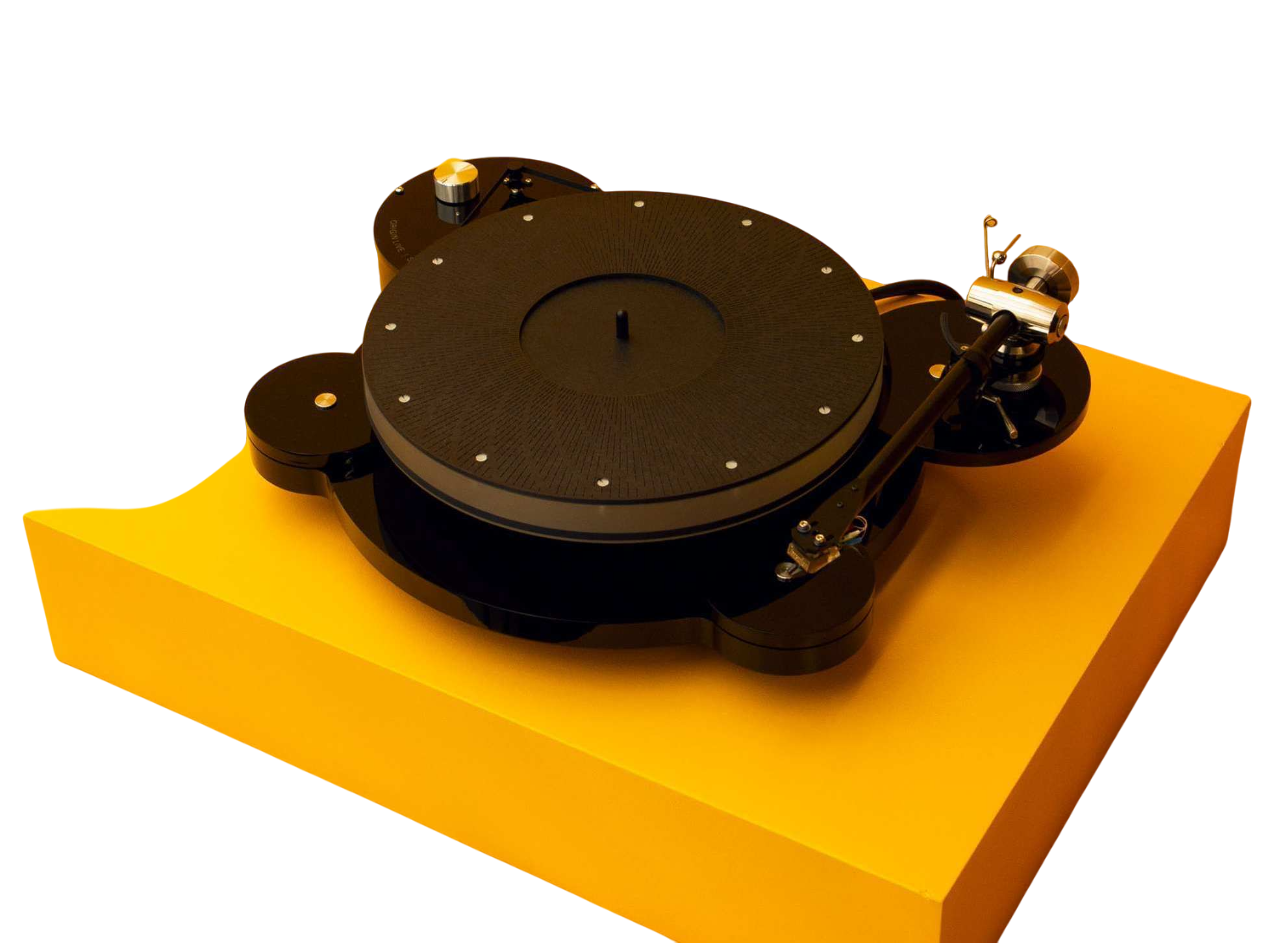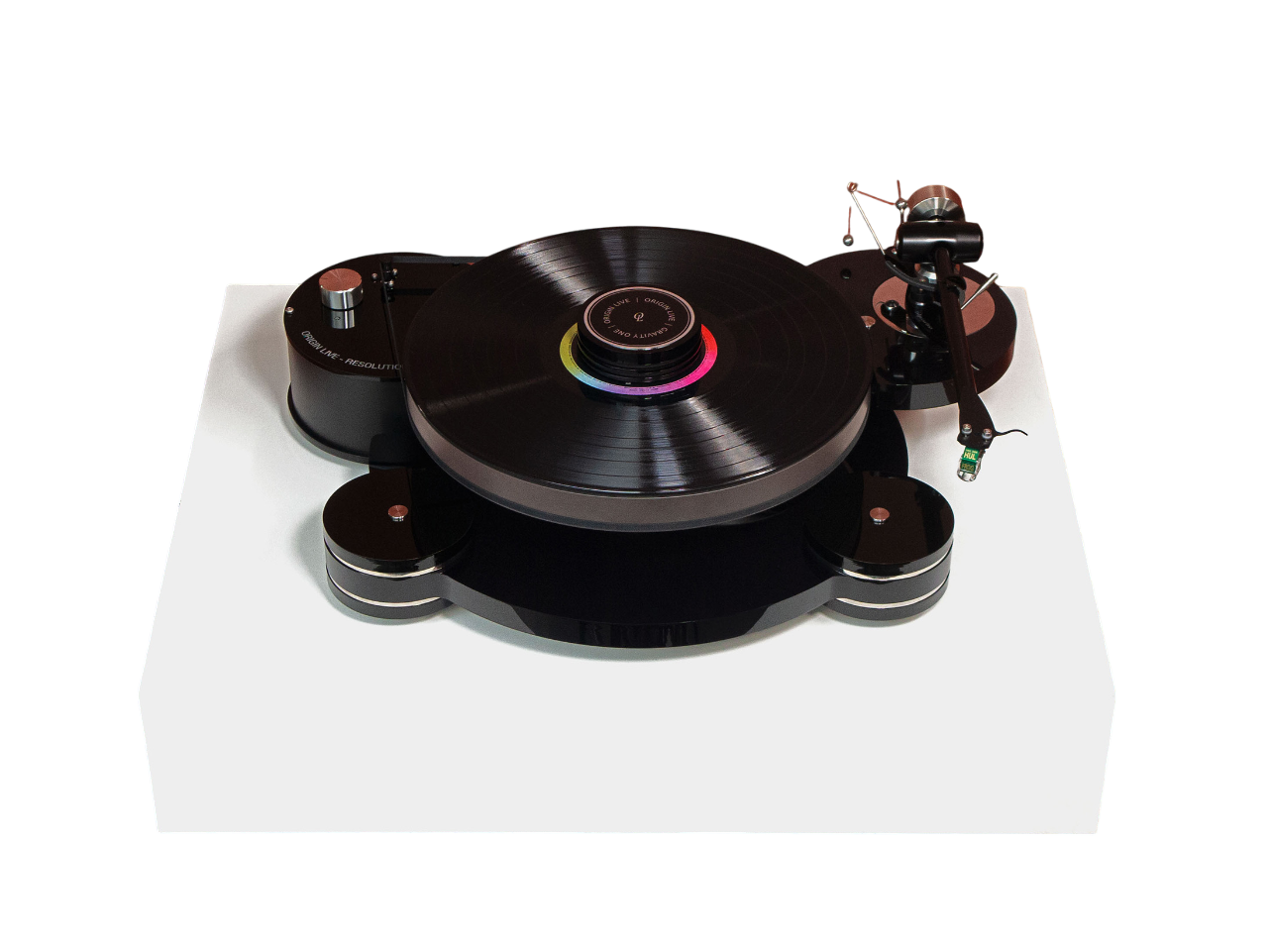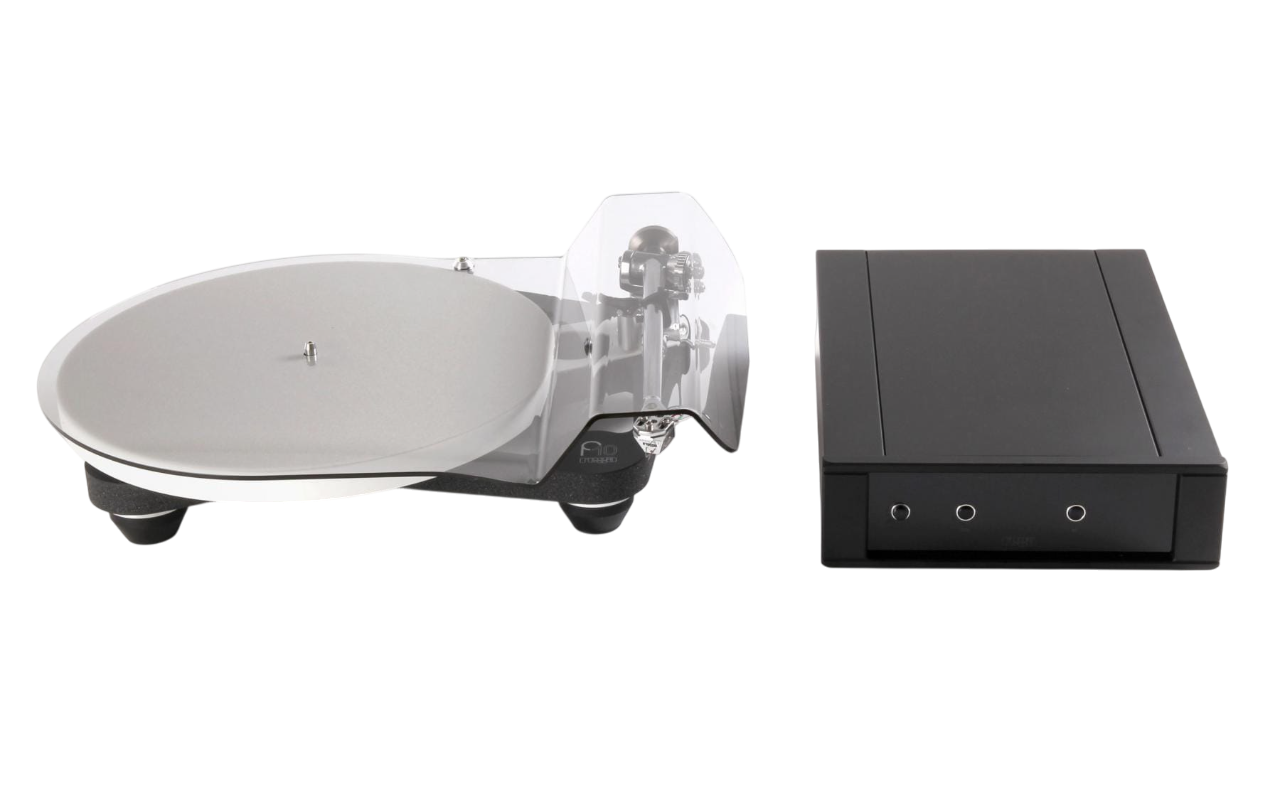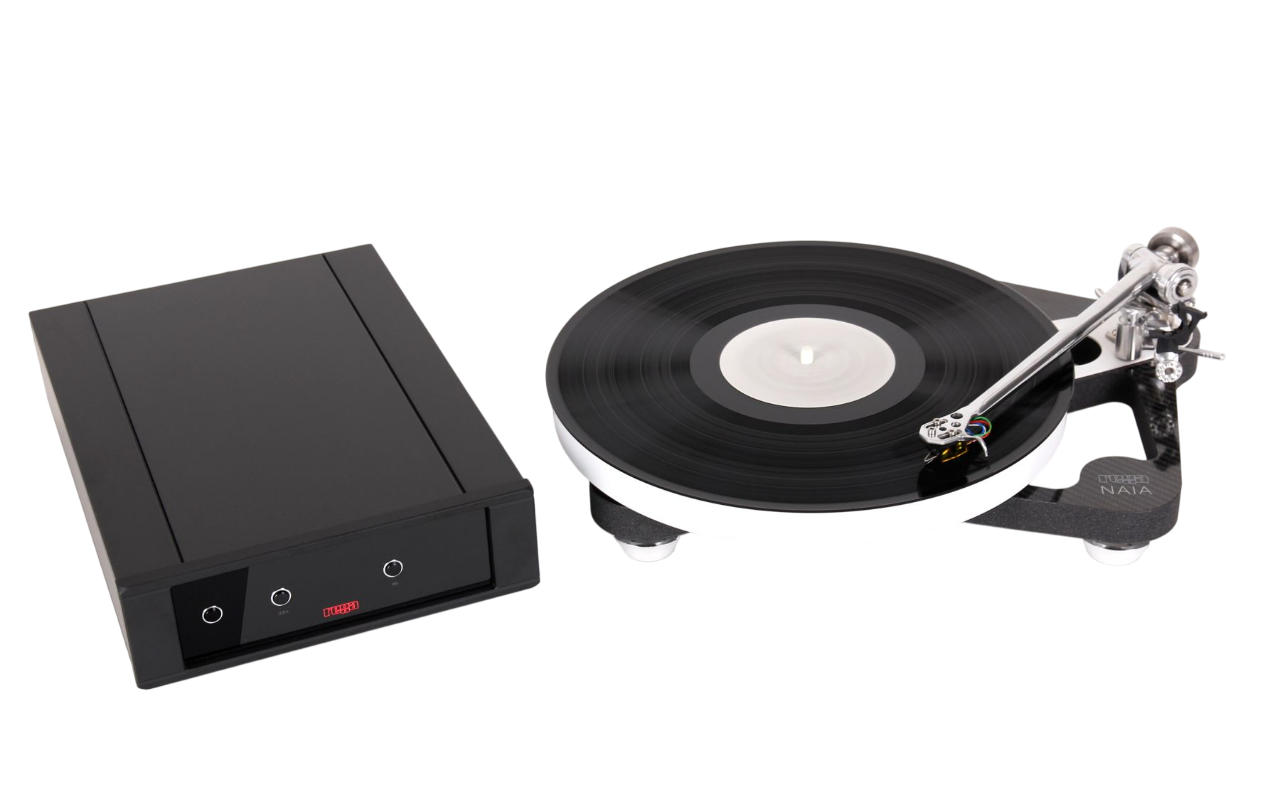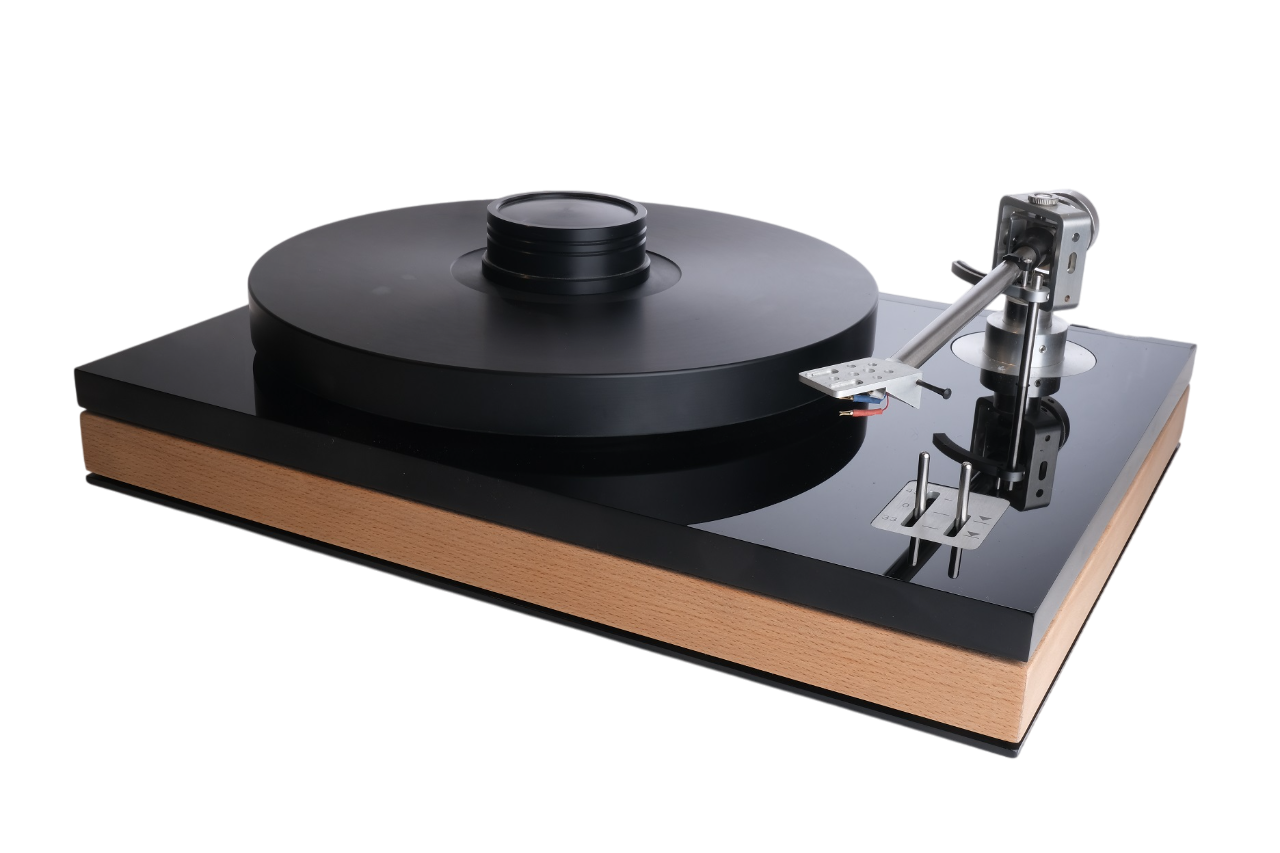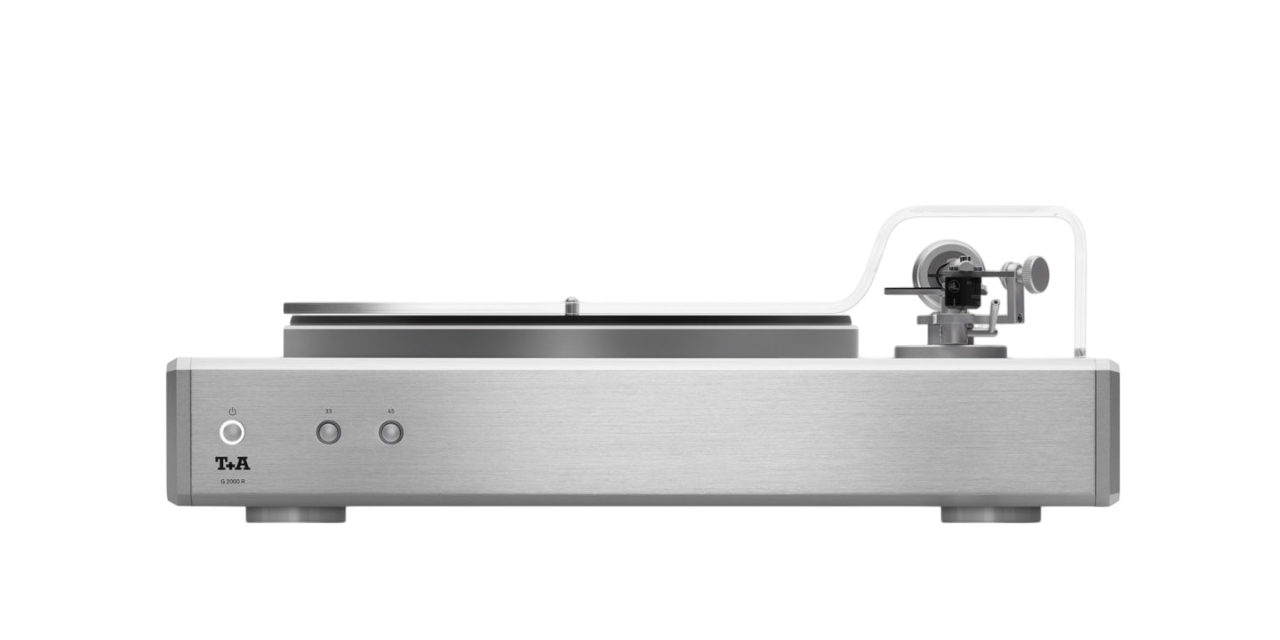SpeedPod
You control the speed with the SpeedPod, a small external unit. It switches between 33.33 and 45 RPM, and lets you make fine adjustments in 0.01 RPM steps — helpful for older records or tuning by ear. Designed to integrate seamlessly, the SpeedPod fits precisely under the Takumi chassis.
It is Newton all over
Playing vinyl on a turntable is a physical wonder. It is all about vibrations. Of course, the vibrations of the sound waves are the most important – after all, you want to listen to music! However, the different parts of a turntable also create vibrations, and this phenomenon must be considered during the construction of a turntable.
For example, did you know that the vibrational waves which are created reach the element and the needle through the base, the tonearm, and other ways? And speaking of the needle… it generates all kinds of forces on the grooves of the record which must be kept under control. According to Newton’s third law, vibration will occur inside the record as the needle scans the groove. The details of your favourite music can be lost or distorted if the turntable is not well designed for these vibrations. Therefore, every force and path that can be travelled by vibration waves must be examined. By making sure that you use the right materials and by connecting them in the right way, your music sounds like never before on the Takumi TT level 2.1 DC.
Stable Speed, Quiet Drive — How the Takumi Spins
Spinning a record might seem simple, but doing it well takes careful engineering. The Takumi 2.1 DC uses a belt drive system, a quiet DC motor, and a smart speed control system to keep everything turning smoothly and precisely. We chose belt drive to reduce vibration. The belt acts like a filter — it helps block small motor movements from reaching the platter. This keeps noise out of the music and improves clarity.
The motor is in its own housing, separated from the main chassis. Inside, we use damping materials to absorb any small movements. A cover over the pulley also helps reduce sound from the motor. The result: very low mechanical noise. But smooth rotation needs more than isolation. The Takumi uses a sensor system that checks the platter speed constantly. A set of magnets under the platter work with a sensor in the base to provide real-time feedback. If the speed drifts even a little, the system adjusts it automatically.
This means better pitch accuracy, better timing, and a more natural flow in the music — even with long listening sessions or hard-to-drive records. The Takumi doesn’t just spin the record. It keeps the speed steady and the music intact — so you hear exactly what was pressed into the groove.
Built for Smooth Rotation — Platter, Subplatter, and Bearing
Spinning a record might seem simple, but doing it well takes careful engineering. The Takumi 2.1 DC uses a belt drive system, a quiet DC motor, and a smart speed control system to keep everything turning smoothly and precisely. We chose belt drive to reduce vibration. The belt acts like a filter — it helps block small motor movements from reaching the platter. This keeps noise out of the music and improves clarity.
The motor is in its own housing, separated from the main chassis. Inside, we use damping materials to absorb any small movements. A cover over the pulley also helps reduce sound from the motor. The result: very low mechanical noise. But smooth rotation needs more than isolation. The Takumi uses a sensor system that checks the platter speed constantly. A set of magnets under the platter work with a sensor in the base to provide real-time feedback. If the speed drifts even a little, the system adjusts it automatically.
This means better pitch accuracy, better timing, and a more natural flow in the music — even with long listening sessions or hard-to-drive records. The Takumi doesn’t just spin the record. It keeps the speed steady and the music intact — so you hear exactly what was pressed into the groove.
Designed for Real Listening
The Takumi 2.1 DC isn’t just about looks or trends. It’s built on solid engineering and refined through careful listening. Every part is chosen to serve one purpose: to deliver clear, natural sound from your records — with no distractions. rom the start, performance came first. Materials, mechanics, and design were selected with one thing in mind: getting the most out of the music — with as little interference as possible.
What looks simple on the outside is carefully designed on the inside. The turntable’s structure, motor, and speed control all work together to support smooth, stable playback. Each part of the system helps make sure the music sounds just as it should. The Takumi doesn’t add color or character. It simply plays what’s in the groove — with great timing, detail, and space. Quiet passages stay quiet. Loud ones hit hard. It lets the record speak for itself.
Built to last and easy to maintain, the Takumi 2.1 DC is made for people who take music seriously. It’s a tool you can trust — now and in the future.
A Solid Foundation — Why We Chose Acrylic
At the heart of the Takumi 2.1 DC is a carefully chosen material: acrylic. We didn’t pick it for looks (though it does look clean and modern). We chose it because it sounds good. Acrylic handles vibrations in a very balanced way. Unlike wood or metal, it doesn’t ring or favor one direction. It spreads energy evenly, which means fewer unwanted resonances — and more natural sound.
Any turntable picks up vibrations — from speakers, from the room, even from the stylus tracking the groove. The base needs to absorb and control those forces. Acrylic does that well. It keeps things stable and quiet, so the music comes through clearly. We machine the acrylic base using high-precision CNC tools. Every cut, hole, and thread is made with tight tolerances. This ensures that the motor, bearing, and tonearm are perfectly aligned — and that nothing shifts or flexes over time.
Acrylic is often used in scientific and optical instruments because it’s strong, consistent, and predictable. Those same qualities make it ideal for audio. It supports the rest of the turntable with calm, silent authority — no matter what kind of music you play.
Precision Where It Counts — The Tonearm and Cable
The tonearm is one of the most critical components of any turntable. It must be both extremely rigid and completely free-moving. Any unwanted flex, resonance, or friction directly affects sound quality. The Takumi 2.1 DC tonearm is designed to avoid these issues through careful material choices and mechanical precision.
The armtube is made from thin-walled titanium. This material combines high stiffness with low mass, allowing the cartridge to track accurately while efficiently guiding vibrations away from the cartridge body toward the bearing block — where they are safely absorbed. The headshell is fixed, not detachable. This design eliminates extra contact points and solder joints, which can introduce resistance, signal loss, or mechanical play. The result is a cleaner electrical path and greater mechanical stability — helping preserve channel separation and detail.
The tonearm uses a full cardanic bearing system, with preloaded radial bearings for near-zero play and extremely low friction. This allows the cartridge to move freely, even with demanding pressings or subtle groove modulations.
The tonearm offers full adjustability for optimal setup:
Vertical Tracking Angle (VTA) via a three-point base system
Azimuth adjustment at the headshell
Anti-skating via a frictionless magnetic system
Armlift height via set screws
These features ensure precise tracking, accurate channel balance, and faithful sound — with no added coloration from the arm itself.
Keeping the Signal Clean — The Phono Cable
The signal from a phono cartridge is extremely small and sensitive. Any disturbance in this part of the system can affect sound quality. That’s why the Takumi 2.1 DC uses a fixed phono cable, directly connected to the internal tonearm wiring — with no connectors or additional solder points at the arm base. The cable is 120 cm long, fully shielded, and equipped with a dual ground system. It uses highquality conductors optimized for low capacitance and low resistance. This helps prevent electromagnetic interference and reduces the chance of hum — especially important in complex, high-resolution audio setups.
By treating the electrical path with the same attention as the mechanical parts, the Takumi 2.1 DC ensures that the signal stays as pure as possible — from stylus to phono stage.
Why No Platter Mat?
Most platter mats create a barrier between the record and the platter, allowing the vinyl to vibrate on its own. This can amplify subtle resonances, which may color the sound, blur transients, and mask fine details. With the Takumi, the record rests directly on the acrylic platter. Because acrylic has similar resonance properties to vinyl, it quickly absorbs micro-vibrations instead of reflecting them back into the stylus. By doing so, we effectively add the mass of the platter to the record itself, forming a single damped unit. This combination is then isolated from the subplatter and spindle by carefully tuned rubber interfaces. The result is greater stability, lower noise, and a cleaner, more focused musical presentation — with preserved clarity, blacker backgrounds, and sharper detail.
Quiet Between the Notes — Controlling Record Vibration
It’s easy to think that a stylus just follows the groove of a record and turns that movement into sound. But there’s more going on. As the stylus tracks the groove, it also pushes back slightly — and that force can make the record itself vibrate.
These small vibrations don’t disappear right away. They can linger for a moment after the stylus has passed. On the next note, the stylus might pick up some of those leftover vibrations. The result isn’t obvious distortion — but it can slightly blur details, reduce impact, or cover up fine textures in the music. To solve this, we use a method called direct coupling. The record sits directly on the acrylic platter — no mat in between. Acrylic has a similar mechanical character to vinyl, so it helps absorb these micro-vibrations and draws them into the platter instead of letting them reflect back into the record.
Stable Support, Quiet Operation — Feet and Isolation
Mechanical isolation plays a major role in how well a turntable performs. Vibrations from the environment — like sound from speakers, footsteps, or room resonance — can travel into the turntable and affect the connection between the stylus and the groove. The Takumi 2.1 DC addresses this with a three-point support system. Using three feet instead of four ensures perfect stability — even on uneven surfaces. Three points always define a flat plane, so the base won’t rock or twist. That stability helps the platter, bearing, and tonearm function exactly as designed.
Each foot is height adjustable, allowing you to level the turntable precisely. Correct leveling is important not only for mechanical reasons, but also to ensure consistent tracking force across the entire surface of the record. Each foot also includes internal vibration damping. These elements help absorb both structural and airborne energy before it reaches sensitive components. The materials are tuned to work across a wide frequency range — from low-frequency room rumble to high-frequency mechanical noise.
Built-In Bubble Level — Easy and Accurate Setup
Setting up a turntable can sometimes be time-consuming, especially when trying to get the chassis perfectly level. To simplify this, the Takumi 2.1 DC includes a precision bubble level built directly into the acrylic base. There’s no need for external tools or guesswork. You can simply adjust the three feet while watching the built-in level, and the turntable will be properly aligned in just a few minutes.
Each foot is height adjustable, allowing you to level the turntable precisely. Correct leveling is important not only for mechanical reasons, but also to ensure consistent tracking force across the entire surface of the record. Each foot also includes internal vibration damping. These elements help absorb both structural and airborne energy before it reaches sensitive components. The materials are tuned to work across a wide frequency range — from low-frequency room rumble to high-frequency mechanical noise.


















